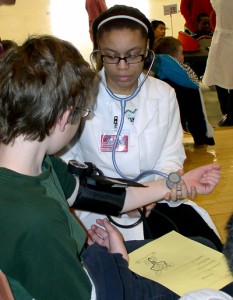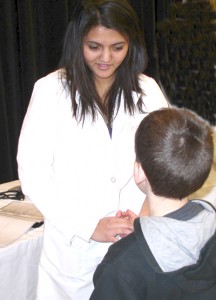RELATED STORY BELOW: Students take their talents to feeder elementary schools
By Casey Hans
AAPSNews Service
A student team sporting white lab coats and professional attire fans out into the VA Ann Arbor Healthcare System for the morning.

The Ann Arbor Public Schools Health Sciences students will observe in surgery and physical therapy, spending time with everyday health professionals.
“We try to build on information they get in the classroom,” said Alex Sciaky, a physical therapist and cardiopulmonary specialist who is working with two students in her area. “They can ask questions and see if they can apply (what they’ve learned.) There is a wide variety for students to see here.
“It’s a very gratifying thing. The students get a lot out of it.”
Students do clinical field work for the year-long program that takes them through one semester of classroom learning at their respective high schools, then places them in six rotating clinical internships throughout the community. In settings such as the VA Ann Arbor Healthcare System, they shadow professionals, observe surgeries and other procedures and get to ask questions of the experts.
“The kids love the opportunity to talk with patients,” said Cathy Malette, a health sciences instructor from Pioneer High School who team-teaches the program with Lynn Boland at Huron High. Both are registered nurses who had careers in the private sector before entering the classroom.
Seniors Nick Blogin from Huron and Wen Ching (Ruth) Wei from Pioneer were at the VA Ann Arbor Healthcare System learning about physical therapy.
Blogin said he plans to study either dentistry or physical therapy when he graduates. “I knew I wanted to do something in the health field for sure,” he said, adding about the Health Sciences program “I thought why not give it a shot?”
Before his trip to the VA Ann Arbor Healthcare System, he had observed oral surgery at Michigan Oral Surgery and pharmacy at U-M and was scheduled to spend time with the U-M Medical Center’s Survival Flight and in the hospital’s emergency room and also had time scheduled to observe at the Ann Arbor Animal Hospital.
Wei did some clinical work in cath labs and in pediatric medicine, orthopedics and obstetrics and gynecology as part of her clinical rotation. She said she is leaning toward surgery as a career.
“I wasn’t sure what I wanted to do last year,” she said. “After the presentation (about Health Sciences) I said ‘I’m so signing up for that.’ I was thinking about doing law and said, now I really want to do this.”
Program prepares students for health careers
The 30-year-old Health Sciences program prepares high school seniors for health-related careers. Most enrolled are from Huron and Pioneer and two students this year are from Community High School. Many have decided to explore medical careers such as physician, nurse, physical therapists or dentists or are students that Malette and Boland feel would be good candidates for study in this area. The program managers also get suggestions from school counselors and other teachers.
“We get feedback from students and parents about how this was a life-changing class,” Malette said. She said the class often exposes students to health careers that they may have never considered.
Malette and Boland work closely with the University of Michigan Health System, Saint Joseph Mercy Health System and the VA Ann Arbor Healthcare System to place students in various areas of health interest. Students ask for their top 10 placements and the teachers try to give students at least their top two choices.
Malette said one young man is studying a variety of ophthalmology clinical settings this year – everything from research to observing eye surgeries and seeing the variety of work he would encounter with both pediatric and aging populations.
“They observe babies being born, work in burn units or with veterinarians; they’re really seeing just about anything,” Malette said.
She noted that the process, which entails keeping patient confidentiality and learning to document, matures students and brings them into a more professional setting. “Our goal is not to just make them competent, but compassionate health care providers, she said. “It’s really quite a privilege to teach this class and mold the next generation.”
Malette said there are similar programs around the state, but that Ann Arbor’s students are fortunate to have three large health systems in their back yard that offer them a variety of experience. “We’re competing with students from everywhere,” she said. “Everybody who has health students, including many from college, wants to get in the door.”
Boland said having an Ann Arbor-based program is unique and that students are fortunate to be here. “A large percentage of our students go on to medical school, nursing and physical therapy, which is now a doctoral program,” she said. “We tell them every day, you are so lucky. Don’t ever take it for granted. It’s an amazing opportunity for them.”
Constant improvements
Although the program is longstanding in the Ann Arbor community, those who work with it are constantly improving it.
This year, for example, the University of Michigan Innovation Center – a research center working to develop and move new ideas ahead for use in the medical system – has invited two students from Pioneer and two from Huron to be on their advisory panel. Students do this on their own time – a complement to their time in the Health Sciences program, Malette said.

“These young, pliable brains have come up with ideas that they’re using,” she said. “For high school students to be able to work on something like this is just incredible.”
Another new program is a partnership between the Health Sciences students and feeder elementary schools on health screening fairs – the brainchild of Thurston Elementary School Principal Pat Manley. Students set up a variety of health-related booths and teach students how to read vital signs, how to best wash and sanitize their hands, work with a mannequin and an AED defibrillator and be part of an anti-smoking booth that has both diseased and healthy pig lungs to show students what smoking can do to their bodies.
Also new this year was an invitation from Dr. Lisa Newman, a surgical oncologist from the U-M Health System, asking the health students to write essays prior to the U-M Medical School’s MLK Day Symposium. They wrote about how they could be a catalyst for change in health care and three students were honored… two as finalists and one who was selected to read her essay before a group of physicians and students during the symposium.
All of the new efforts have enhanced the program, which has graduated hundreds of students over 30 years and placed many into training for the medical profession.
“We’re so proud of it,” said Malette. “We’ve worked hard to make these things happen.”
For more information about the Ann Arbor Health Sciences program, click here.
Clincs for young students offer healthy lessons
From AAPSNews Service
In addition to taking part in clinical settings in their second semester, Ann Arbor’s Health Sciences students also spend time teaching and working with young students in Ann Arbor, sponsoring hands-on health clinics in their feeder elementary schools.
On this day, Huron High School Health Sciences students take fifth-graders through the paces at King Elementary School, where students are learning at four different stations.

Kaisa Wayrynen and Abby Pianelli are handling the most popular station for a fifth-grade class: One that shows a healthy pig lung and another ravaged from smoking. “Do you guys want lungs like this?” Pianelli asks students.
“For most people, it takes them a lifetime to get their lungs like this,” Wayrynen tells students. “Look at this, you can’t breathe.”
Students wanted to discuss why some kids begin to smoke. “A lot of people think smoking is cool,” Wayrynen said. “But when you smoke, you can’t do much. You can’t run; you can’t play sports at all. You can’t even carry a backpack very well. And that would limit your life.”
Other stations included: how to use an automatic AED defibrillator, taking students’ vital signs and one teaching germs, where Erica Skillman is explaining the difference between viral and bacterial germs to students. “When you get a cold, your doctor can give you something to make you feel better, but can’t cure it. The virus has to work its way out of your system,” she said.
Many Huron students said they had an interest in health care and medical professions before signing up for the Health Sciences program. “I think I like it a lot now that I have done it,” said Tamara Slay, who plans to attend Washtenaw Community College and transfer to Eastern Michigan University for nursing.
Kara Henderson also plans on a career in nursing with a WCC and Eastern education. She said a clinic time at the University of Michigan Cast Clinic caught her interest. “I had an interest in the medical field,” she said. “This has really been a good experience for me.”
Neonatal nursing is what Lindsey Lawson has in mind for her future career. “I’m getting to do hands-on things. It’s exciting,” she said of the clinicals. “I want to be exposed to things – that’s why I came.” She plans to begin her college career at WCC then move onto U-M.
Lynn Boland, the Huron High Health Sciences teacher, said the students are getting experience with a variety of age levels by visiting the elementary schools. Teaching is an important part of being a professional in the health field, and this exercise exposes them to that, she said.
••••••••••••••••••••••••••••••••••••••••••••••••••••••••••••••••••••••••••••••••••••••••••••••••••••••
Ann Arbor’s Health Sciences Program
honors students with opportunities and awards
U-M Medical Innovation Center:
New this year, two students from each school were invited to be members of the Medical Innovation Center, a collaboration of professionals who have formed to, as the name says, develop innovations for the U-M Health System. Students selected this year include:
Huron High School: Ben Case and Renee Philson
Pioneer High School: Dhaatri Kuchipudi and Liane Racelis
U-M MLK Medical Symposium:
Also new this year, health sciences students were invited to submit essays as part of the MLK Symposium at the U-M Medical School. Students wrote about “Catalyst for Change in Health Care.” The finalist read her essay at the symposium and had lunch with Dr. Lisa Newman, a surgical oncologist and keynote speaker for the event. Students honored included:
Essay Winner: Lauren Phillips of Pioneer.
Finalists: Wen-Ching (Ruth) Wei and Bala Naveen Kakaraparthi, both of Pioneer.
Health Occupations Students of America:
Ann Arbor Health Sciences students entered the HOSA competition and did well at both regional and state events. Following are links that list winners and their accomplishments:
Region 3 Leadership Conference awards
Michigan HOSA 2010 State Leadership Conference awards were April 15-16.
Casey Hans edits this newsletter for The Ann Arbor Public Schools. E-mail her or call 734-994-2090.

